Higher Education Skills and Competencies
VerifiedAdded on 2024/04/26
|12
|2207
|404
AI Summary
This assignment explores the differences between school and higher education environments, emphasizing critical reading, thinking, and information evaluation. It also discusses the importance of skills development and the impact of learning environments on academic progress.
Contribute Materials
Your contribution can guide someone’s learning journey. Share your
documents today.
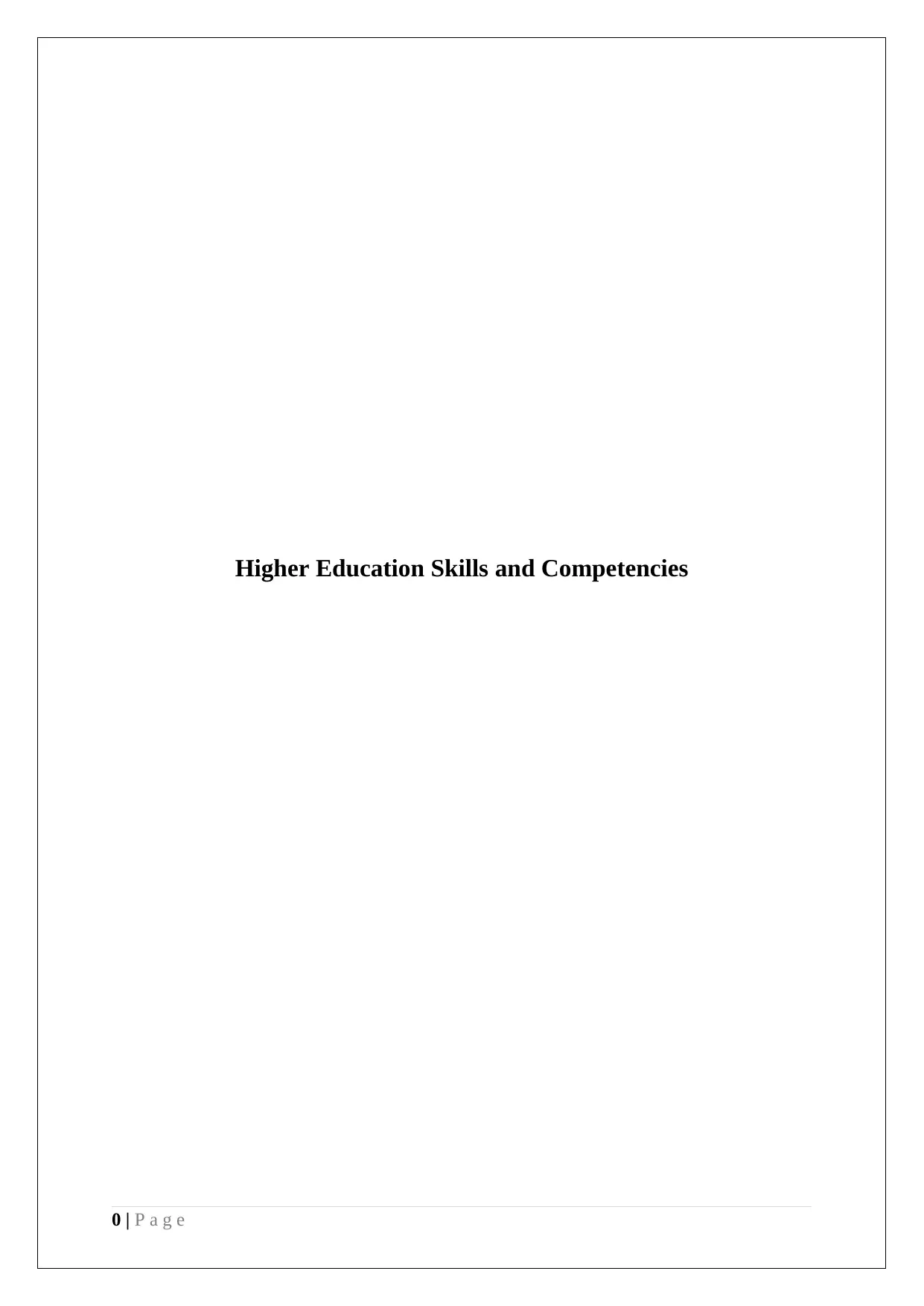
Higher Education Skills and Competencies
0 | P a g e
0 | P a g e
Secure Best Marks with AI Grader
Need help grading? Try our AI Grader for instant feedback on your assignments.
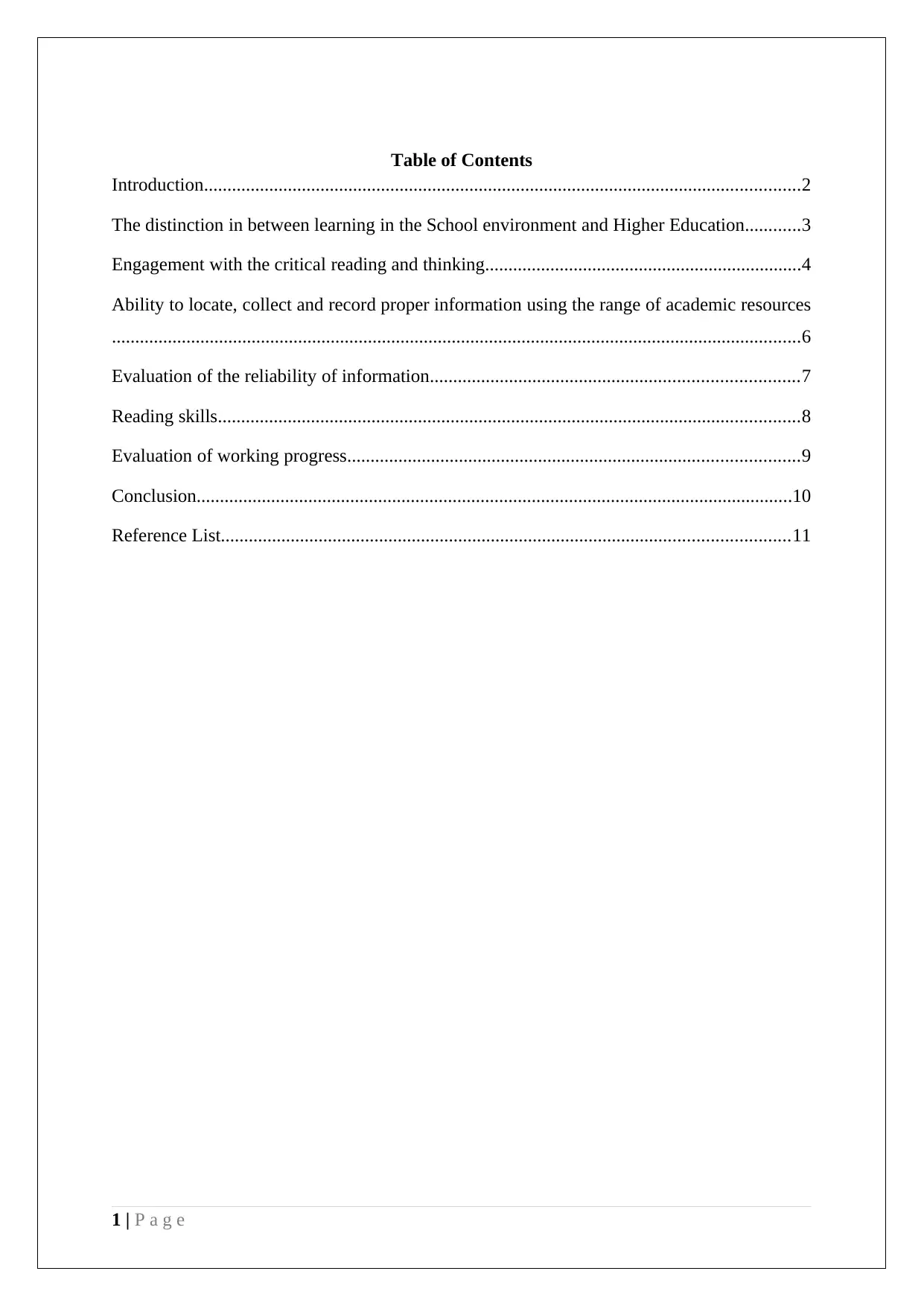
Table of Contents
Introduction................................................................................................................................2
The distinction in between learning in the School environment and Higher Education............3
Engagement with the critical reading and thinking....................................................................4
Ability to locate, collect and record proper information using the range of academic resources
....................................................................................................................................................6
Evaluation of the reliability of information...............................................................................7
Reading skills.............................................................................................................................8
Evaluation of working progress.................................................................................................9
Conclusion................................................................................................................................10
Reference List..........................................................................................................................11
1 | P a g e
Introduction................................................................................................................................2
The distinction in between learning in the School environment and Higher Education............3
Engagement with the critical reading and thinking....................................................................4
Ability to locate, collect and record proper information using the range of academic resources
....................................................................................................................................................6
Evaluation of the reliability of information...............................................................................7
Reading skills.............................................................................................................................8
Evaluation of working progress.................................................................................................9
Conclusion................................................................................................................................10
Reference List..........................................................................................................................11
1 | P a g e

Introduction
The main objective of this assignment is to elaborate the improvement and implement of the
school environment as well as higher education. Through this assignment it will be easy to
identify the skills that are needed to be developed. The main difference in between the higher
education and the school is regarded as the importance of the self management research. I
evaluate all the important factors of the critical learning and critical thinking through this
self-reflective assignment. The learning and thinking critically play a vital role on the
academic progress.
2 | P a g e
The main objective of this assignment is to elaborate the improvement and implement of the
school environment as well as higher education. Through this assignment it will be easy to
identify the skills that are needed to be developed. The main difference in between the higher
education and the school is regarded as the importance of the self management research. I
evaluate all the important factors of the critical learning and critical thinking through this
self-reflective assignment. The learning and thinking critically play a vital role on the
academic progress.
2 | P a g e
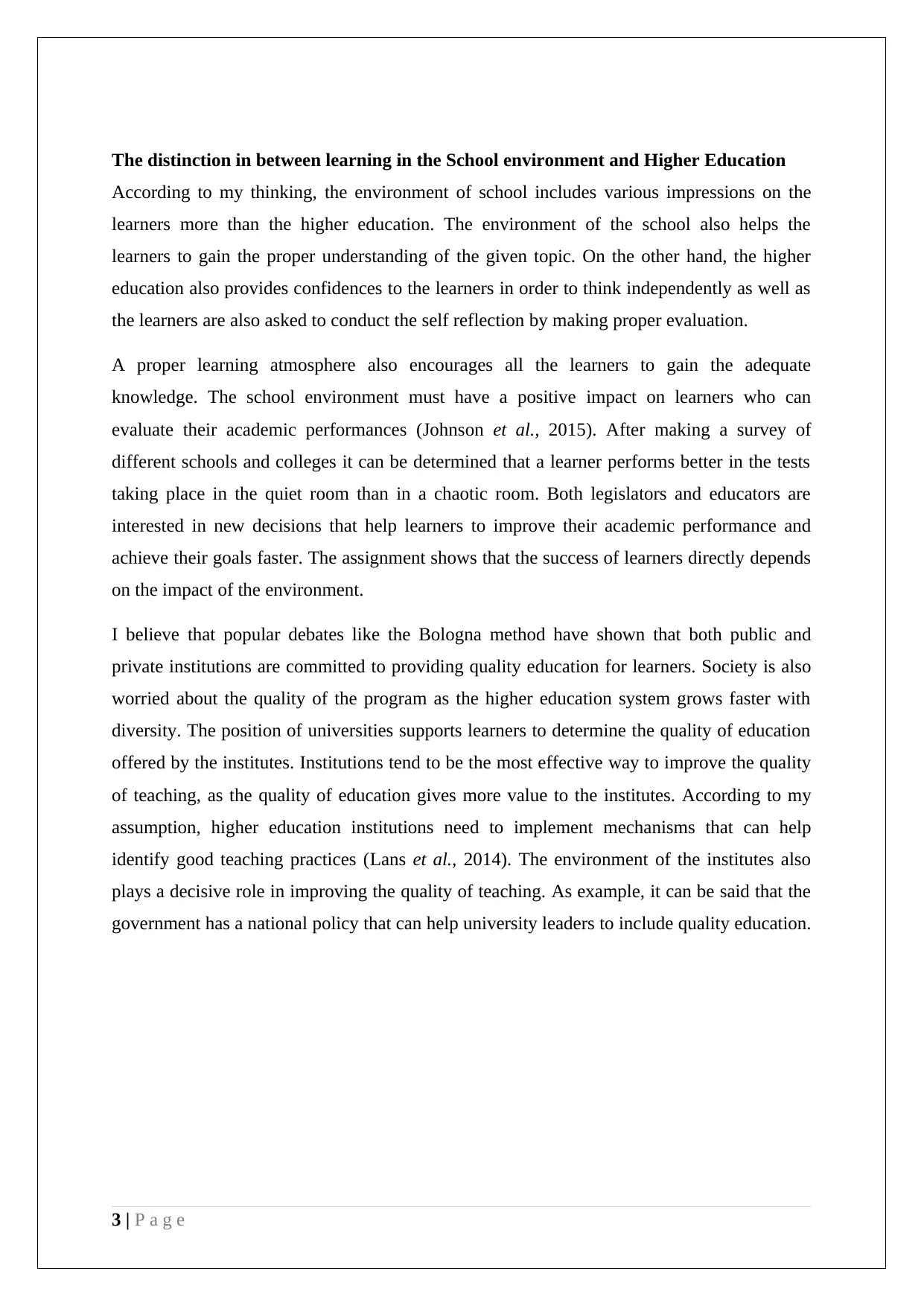
The distinction in between learning in the School environment and Higher Education
According to my thinking, the environment of school includes various impressions on the
learners more than the higher education. The environment of the school also helps the
learners to gain the proper understanding of the given topic. On the other hand, the higher
education also provides confidences to the learners in order to think independently as well as
the learners are also asked to conduct the self reflection by making proper evaluation.
A proper learning atmosphere also encourages all the learners to gain the adequate
knowledge. The school environment must have a positive impact on learners who can
evaluate their academic performances (Johnson et al., 2015). After making a survey of
different schools and colleges it can be determined that a learner performs better in the tests
taking place in the quiet room than in a chaotic room. Both legislators and educators are
interested in new decisions that help learners to improve their academic performance and
achieve their goals faster. The assignment shows that the success of learners directly depends
on the impact of the environment.
I believe that popular debates like the Bologna method have shown that both public and
private institutions are committed to providing quality education for learners. Society is also
worried about the quality of the program as the higher education system grows faster with
diversity. The position of universities supports learners to determine the quality of education
offered by the institutes. Institutions tend to be the most effective way to improve the quality
of teaching, as the quality of education gives more value to the institutes. According to my
assumption, higher education institutions need to implement mechanisms that can help
identify good teaching practices (Lans et al., 2014). The environment of the institutes also
plays a decisive role in improving the quality of teaching. As example, it can be said that the
government has a national policy that can help university leaders to include quality education.
3 | P a g e
According to my thinking, the environment of school includes various impressions on the
learners more than the higher education. The environment of the school also helps the
learners to gain the proper understanding of the given topic. On the other hand, the higher
education also provides confidences to the learners in order to think independently as well as
the learners are also asked to conduct the self reflection by making proper evaluation.
A proper learning atmosphere also encourages all the learners to gain the adequate
knowledge. The school environment must have a positive impact on learners who can
evaluate their academic performances (Johnson et al., 2015). After making a survey of
different schools and colleges it can be determined that a learner performs better in the tests
taking place in the quiet room than in a chaotic room. Both legislators and educators are
interested in new decisions that help learners to improve their academic performance and
achieve their goals faster. The assignment shows that the success of learners directly depends
on the impact of the environment.
I believe that popular debates like the Bologna method have shown that both public and
private institutions are committed to providing quality education for learners. Society is also
worried about the quality of the program as the higher education system grows faster with
diversity. The position of universities supports learners to determine the quality of education
offered by the institutes. Institutions tend to be the most effective way to improve the quality
of teaching, as the quality of education gives more value to the institutes. According to my
assumption, higher education institutions need to implement mechanisms that can help
identify good teaching practices (Lans et al., 2014). The environment of the institutes also
plays a decisive role in improving the quality of teaching. As example, it can be said that the
government has a national policy that can help university leaders to include quality education.
3 | P a g e
Secure Best Marks with AI Grader
Need help grading? Try our AI Grader for instant feedback on your assignments.
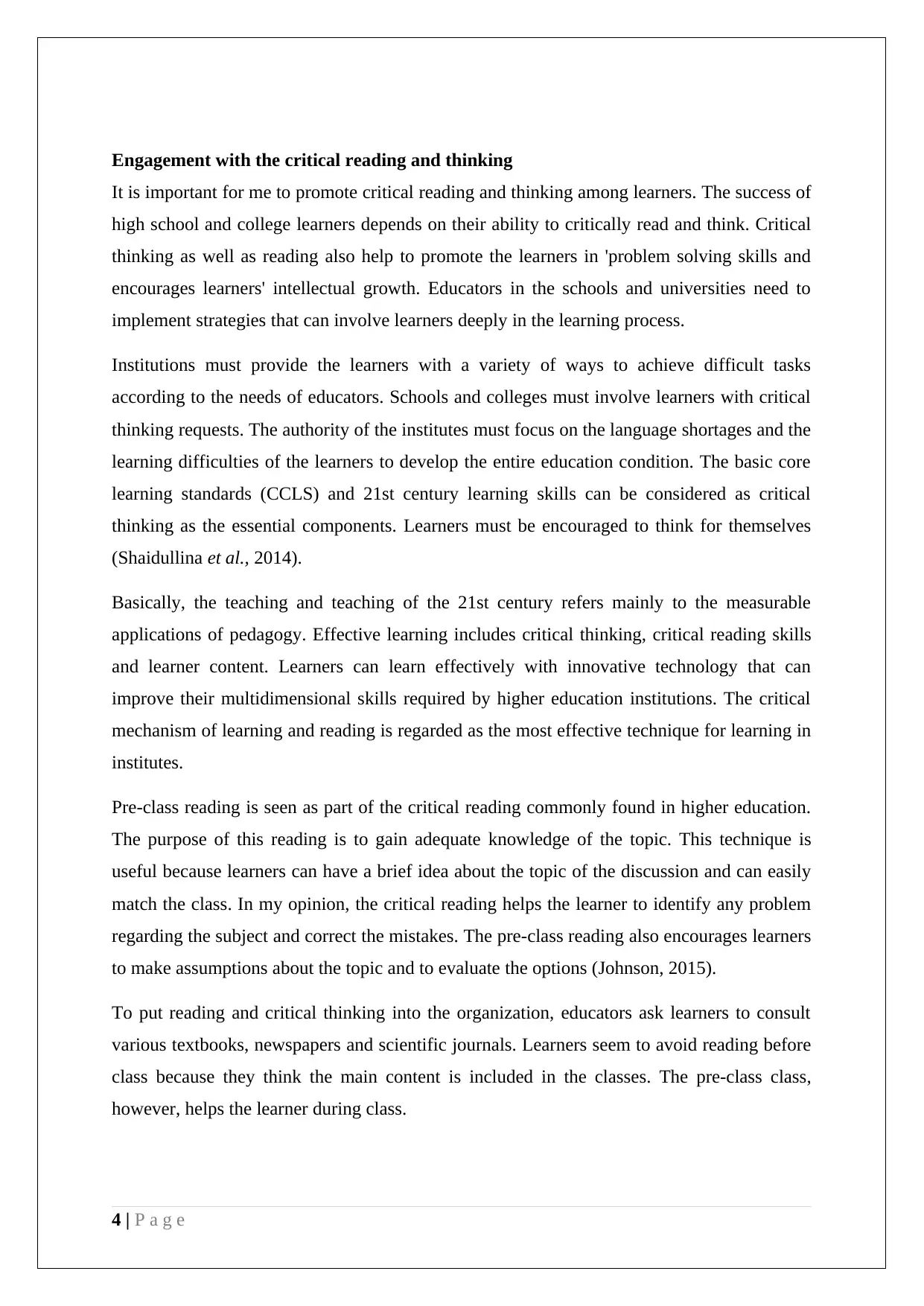
Engagement with the critical reading and thinking
It is important for me to promote critical reading and thinking among learners. The success of
high school and college learners depends on their ability to critically read and think. Critical
thinking as well as reading also help to promote the learners in 'problem solving skills and
encourages learners' intellectual growth. Educators in the schools and universities need to
implement strategies that can involve learners deeply in the learning process.
Institutions must provide the learners with a variety of ways to achieve difficult tasks
according to the needs of educators. Schools and colleges must involve learners with critical
thinking requests. The authority of the institutes must focus on the language shortages and the
learning difficulties of the learners to develop the entire education condition. The basic core
learning standards (CCLS) and 21st century learning skills can be considered as critical
thinking as the essential components. Learners must be encouraged to think for themselves
(Shaidullina et al., 2014).
Basically, the teaching and teaching of the 21st century refers mainly to the measurable
applications of pedagogy. Effective learning includes critical thinking, critical reading skills
and learner content. Learners can learn effectively with innovative technology that can
improve their multidimensional skills required by higher education institutions. The critical
mechanism of learning and reading is regarded as the most effective technique for learning in
institutes.
Pre-class reading is seen as part of the critical reading commonly found in higher education.
The purpose of this reading is to gain adequate knowledge of the topic. This technique is
useful because learners can have a brief idea about the topic of the discussion and can easily
match the class. In my opinion, the critical reading helps the learner to identify any problem
regarding the subject and correct the mistakes. The pre-class reading also encourages learners
to make assumptions about the topic and to evaluate the options (Johnson, 2015).
To put reading and critical thinking into the organization, educators ask learners to consult
various textbooks, newspapers and scientific journals. Learners seem to avoid reading before
class because they think the main content is included in the classes. The pre-class class,
however, helps the learner during class.
4 | P a g e
It is important for me to promote critical reading and thinking among learners. The success of
high school and college learners depends on their ability to critically read and think. Critical
thinking as well as reading also help to promote the learners in 'problem solving skills and
encourages learners' intellectual growth. Educators in the schools and universities need to
implement strategies that can involve learners deeply in the learning process.
Institutions must provide the learners with a variety of ways to achieve difficult tasks
according to the needs of educators. Schools and colleges must involve learners with critical
thinking requests. The authority of the institutes must focus on the language shortages and the
learning difficulties of the learners to develop the entire education condition. The basic core
learning standards (CCLS) and 21st century learning skills can be considered as critical
thinking as the essential components. Learners must be encouraged to think for themselves
(Shaidullina et al., 2014).
Basically, the teaching and teaching of the 21st century refers mainly to the measurable
applications of pedagogy. Effective learning includes critical thinking, critical reading skills
and learner content. Learners can learn effectively with innovative technology that can
improve their multidimensional skills required by higher education institutions. The critical
mechanism of learning and reading is regarded as the most effective technique for learning in
institutes.
Pre-class reading is seen as part of the critical reading commonly found in higher education.
The purpose of this reading is to gain adequate knowledge of the topic. This technique is
useful because learners can have a brief idea about the topic of the discussion and can easily
match the class. In my opinion, the critical reading helps the learner to identify any problem
regarding the subject and correct the mistakes. The pre-class reading also encourages learners
to make assumptions about the topic and to evaluate the options (Johnson, 2015).
To put reading and critical thinking into the organization, educators ask learners to consult
various textbooks, newspapers and scientific journals. Learners seem to avoid reading before
class because they think the main content is included in the classes. The pre-class class,
however, helps the learner during class.
4 | P a g e

Critical thinking is an essential part of learner engagement. According to my assumptions,
educators use critical thinking about high school courses. Critical thinking includes examples
of studies, projects with tasks and activities. Critical thinking has been applied after 37 years
of research in the educational process. In this process, learners are encouraged to choose a
key concept of the curriculum. After they have chosen the concept, they are asked to
investigate the subject and establish perceptions about the topic. Learners should provide real
examples related to the topic that can help them to develop a report according to their
understanding.
In essence, critical reading leads to critical learning. Learners may otherwise qualify a
learning material based on their understanding (Goetsch and Davis, 2014). Learners’
response to assignments helps educators to understand the depth of learner knowledge. This
process helps learners explore their own mistakes and correct them correctly.
5 | P a g e
educators use critical thinking about high school courses. Critical thinking includes examples
of studies, projects with tasks and activities. Critical thinking has been applied after 37 years
of research in the educational process. In this process, learners are encouraged to choose a
key concept of the curriculum. After they have chosen the concept, they are asked to
investigate the subject and establish perceptions about the topic. Learners should provide real
examples related to the topic that can help them to develop a report according to their
understanding.
In essence, critical reading leads to critical learning. Learners may otherwise qualify a
learning material based on their understanding (Goetsch and Davis, 2014). Learners’
response to assignments helps educators to understand the depth of learner knowledge. This
process helps learners explore their own mistakes and correct them correctly.
5 | P a g e
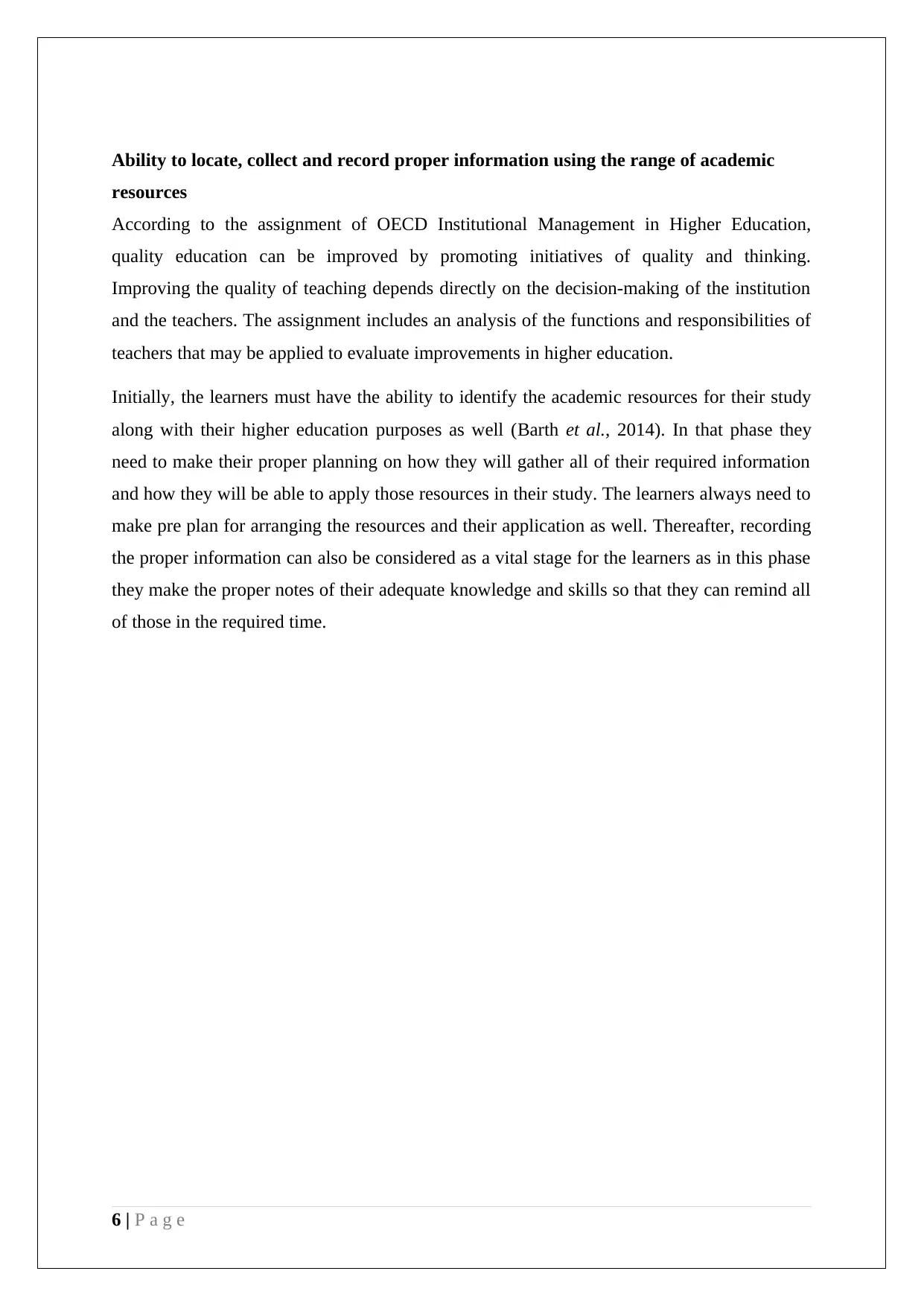
Ability to locate, collect and record proper information using the range of academic
resources
According to the assignment of OECD Institutional Management in Higher Education,
quality education can be improved by promoting initiatives of quality and thinking.
Improving the quality of teaching depends directly on the decision-making of the institution
and the teachers. The assignment includes an analysis of the functions and responsibilities of
teachers that may be applied to evaluate improvements in higher education.
Initially, the learners must have the ability to identify the academic resources for their study
along with their higher education purposes as well (Barth et al., 2014). In that phase they
need to make their proper planning on how they will gather all of their required information
and how they will be able to apply those resources in their study. The learners always need to
make pre plan for arranging the resources and their application as well. Thereafter, recording
the proper information can also be considered as a vital stage for the learners as in this phase
they make the proper notes of their adequate knowledge and skills so that they can remind all
of those in the required time.
6 | P a g e
resources
According to the assignment of OECD Institutional Management in Higher Education,
quality education can be improved by promoting initiatives of quality and thinking.
Improving the quality of teaching depends directly on the decision-making of the institution
and the teachers. The assignment includes an analysis of the functions and responsibilities of
teachers that may be applied to evaluate improvements in higher education.
Initially, the learners must have the ability to identify the academic resources for their study
along with their higher education purposes as well (Barth et al., 2014). In that phase they
need to make their proper planning on how they will gather all of their required information
and how they will be able to apply those resources in their study. The learners always need to
make pre plan for arranging the resources and their application as well. Thereafter, recording
the proper information can also be considered as a vital stage for the learners as in this phase
they make the proper notes of their adequate knowledge and skills so that they can remind all
of those in the required time.
6 | P a g e
Paraphrase This Document
Need a fresh take? Get an instant paraphrase of this document with our AI Paraphraser
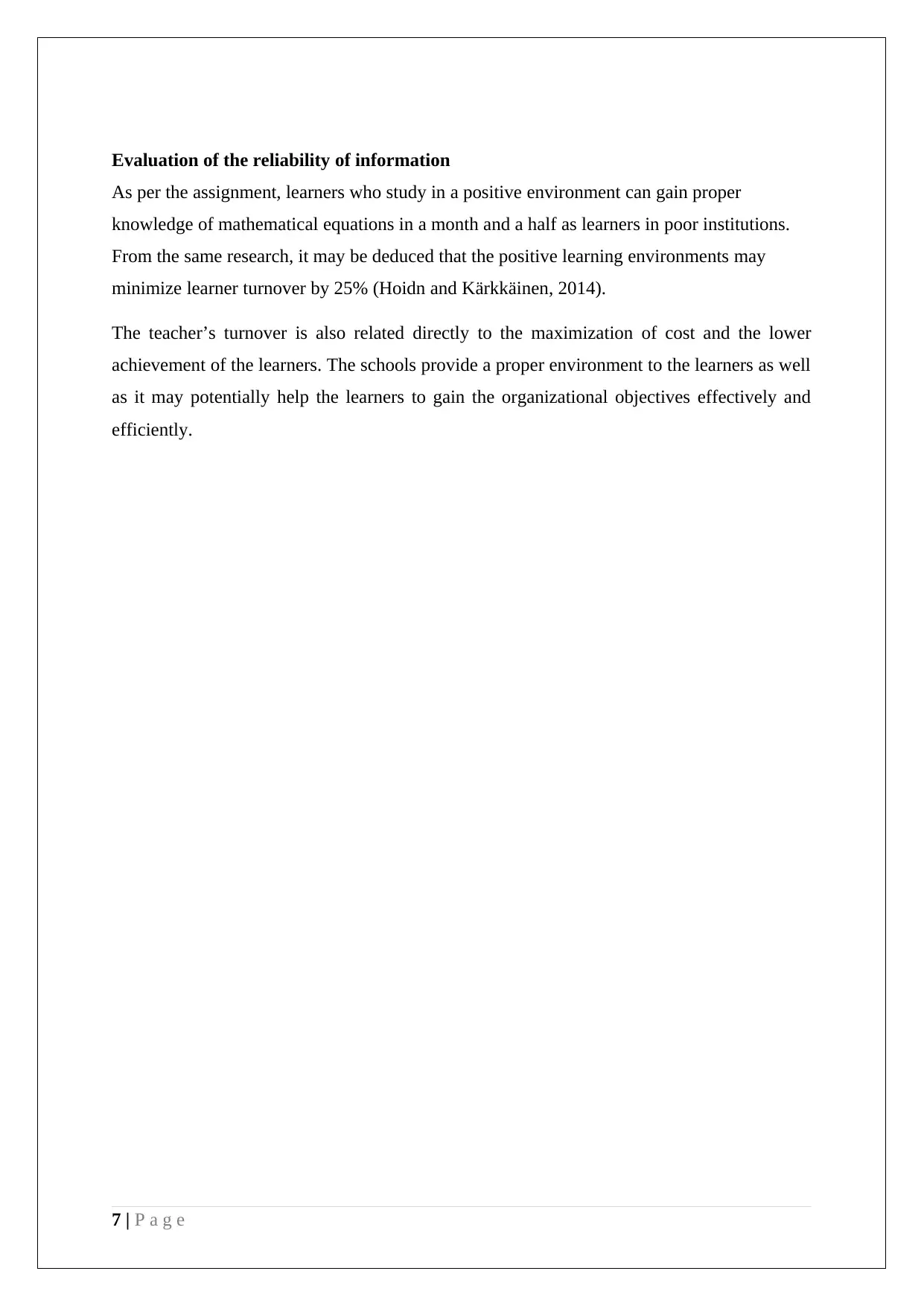
Evaluation of the reliability of information
As per the assignment, learners who study in a positive environment can gain proper
knowledge of mathematical equations in a month and a half as learners in poor institutions.
From the same research, it may be deduced that the positive learning environments may
minimize learner turnover by 25% (Hoidn and Kärkkäinen, 2014).
The teacher’s turnover is also related directly to the maximization of cost and the lower
achievement of the learners. The schools provide a proper environment to the learners as well
as it may potentially help the learners to gain the organizational objectives effectively and
efficiently.
7 | P a g e
As per the assignment, learners who study in a positive environment can gain proper
knowledge of mathematical equations in a month and a half as learners in poor institutions.
From the same research, it may be deduced that the positive learning environments may
minimize learner turnover by 25% (Hoidn and Kärkkäinen, 2014).
The teacher’s turnover is also related directly to the maximization of cost and the lower
achievement of the learners. The schools provide a proper environment to the learners as well
as it may potentially help the learners to gain the organizational objectives effectively and
efficiently.
7 | P a g e

Reading skills
The skill of reading mainly depicts about the ability of the learners to read more. According
to me, in order to gain more knowledge on the learning topic, reading can be considered as
the most important phase (Becker et al., 2017). There are multiple factors that have a positive
impact on learners, like the inter connection in between learners and teachers in case of
academic expectations. The efficient and effective connection in between the learners and the
teachers also helps learners in case of understanding and developing their academic
performance. The teachers act as a leader in case of reading skills as they provide the
guidelines for reading.
8 | P a g e
The skill of reading mainly depicts about the ability of the learners to read more. According
to me, in order to gain more knowledge on the learning topic, reading can be considered as
the most important phase (Becker et al., 2017). There are multiple factors that have a positive
impact on learners, like the inter connection in between learners and teachers in case of
academic expectations. The efficient and effective connection in between the learners and the
teachers also helps learners in case of understanding and developing their academic
performance. The teachers act as a leader in case of reading skills as they provide the
guidelines for reading.
8 | P a g e
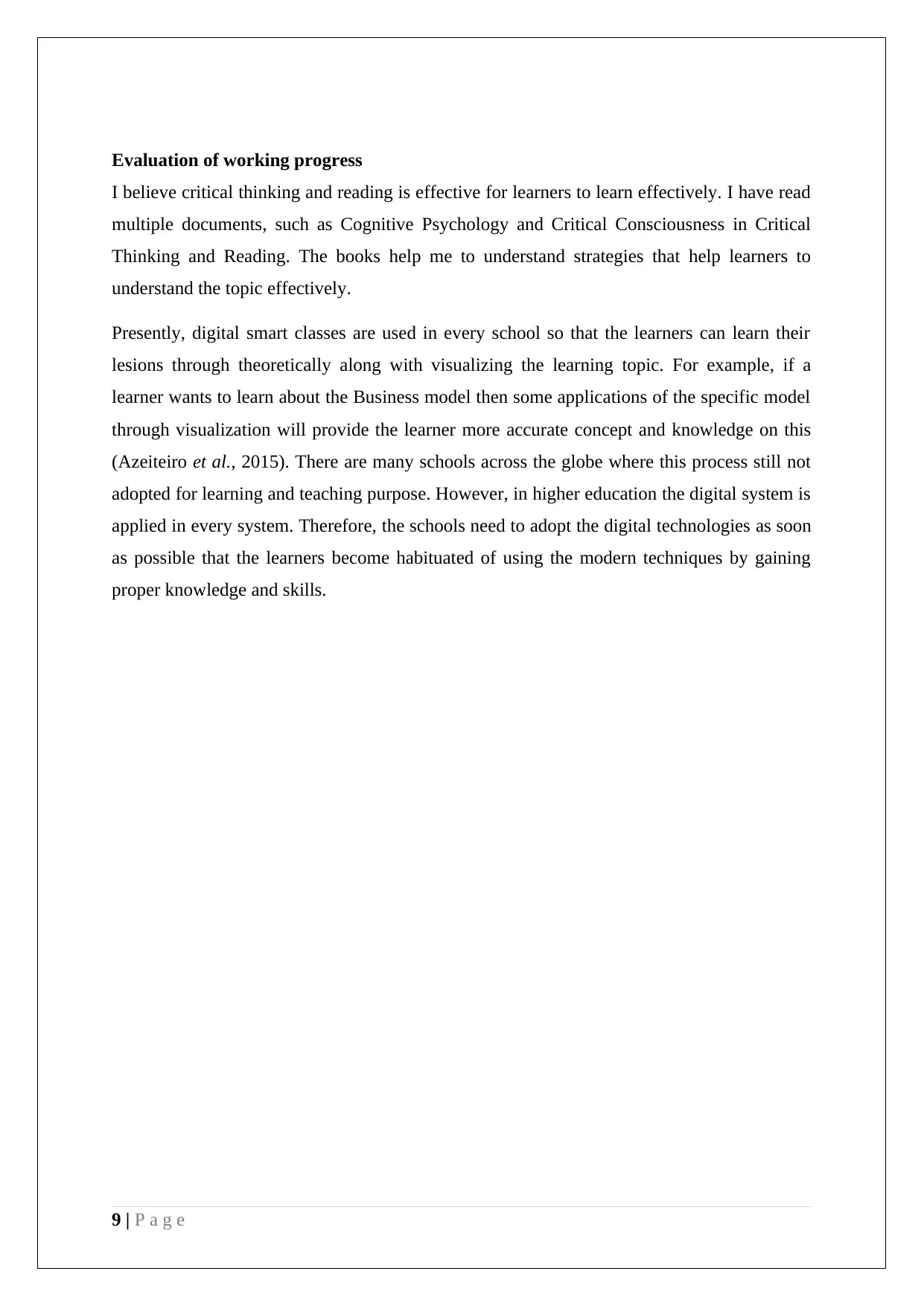
Evaluation of working progress
I believe critical thinking and reading is effective for learners to learn effectively. I have read
multiple documents, such as Cognitive Psychology and Critical Consciousness in Critical
Thinking and Reading. The books help me to understand strategies that help learners to
understand the topic effectively.
Presently, digital smart classes are used in every school so that the learners can learn their
lesions through theoretically along with visualizing the learning topic. For example, if a
learner wants to learn about the Business model then some applications of the specific model
through visualization will provide the learner more accurate concept and knowledge on this
(Azeiteiro et al., 2015). There are many schools across the globe where this process still not
adopted for learning and teaching purpose. However, in higher education the digital system is
applied in every system. Therefore, the schools need to adopt the digital technologies as soon
as possible that the learners become habituated of using the modern techniques by gaining
proper knowledge and skills.
9 | P a g e
I believe critical thinking and reading is effective for learners to learn effectively. I have read
multiple documents, such as Cognitive Psychology and Critical Consciousness in Critical
Thinking and Reading. The books help me to understand strategies that help learners to
understand the topic effectively.
Presently, digital smart classes are used in every school so that the learners can learn their
lesions through theoretically along with visualizing the learning topic. For example, if a
learner wants to learn about the Business model then some applications of the specific model
through visualization will provide the learner more accurate concept and knowledge on this
(Azeiteiro et al., 2015). There are many schools across the globe where this process still not
adopted for learning and teaching purpose. However, in higher education the digital system is
applied in every system. Therefore, the schools need to adopt the digital technologies as soon
as possible that the learners become habituated of using the modern techniques by gaining
proper knowledge and skills.
9 | P a g e
Secure Best Marks with AI Grader
Need help grading? Try our AI Grader for instant feedback on your assignments.
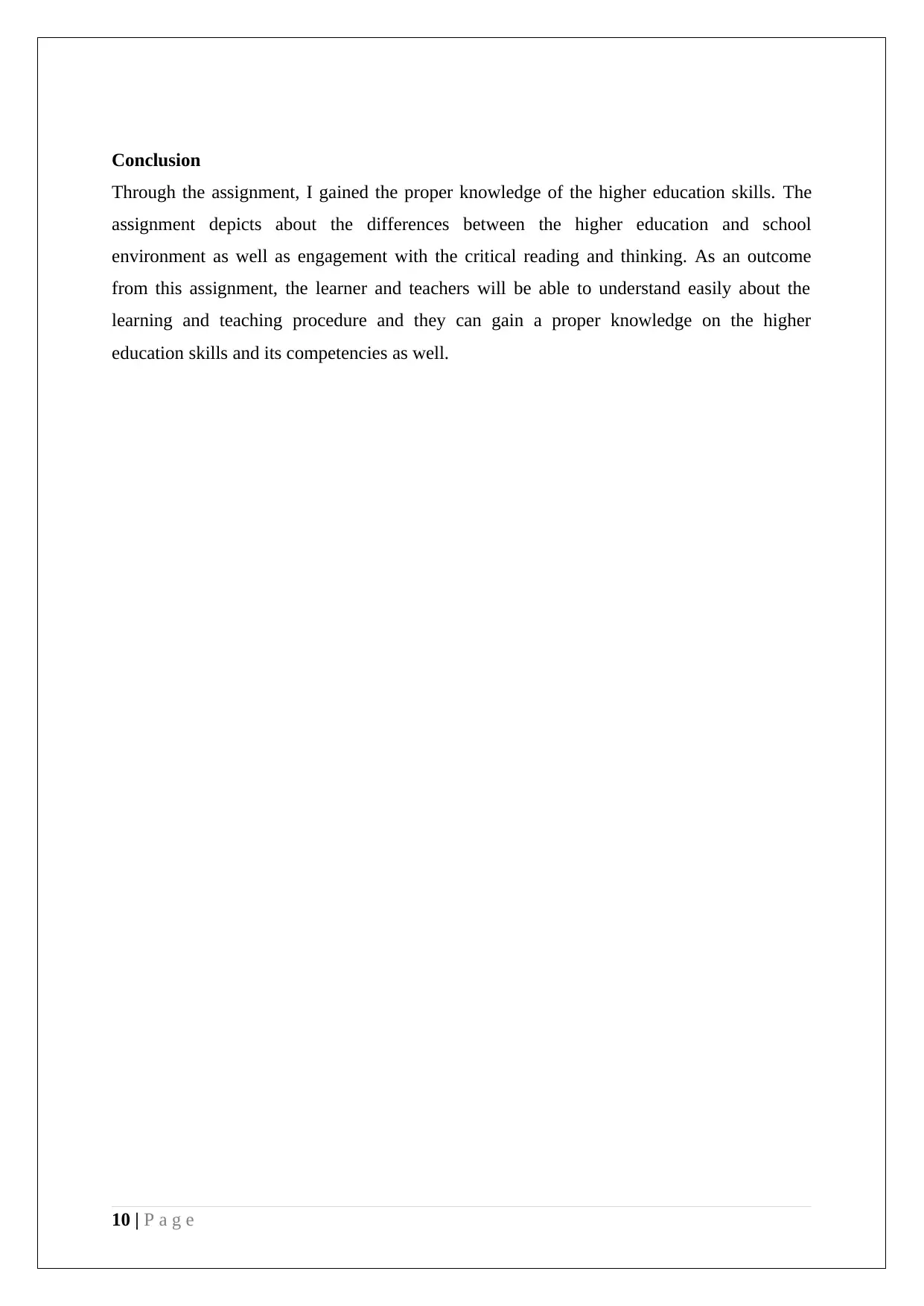
Conclusion
Through the assignment, I gained the proper knowledge of the higher education skills. The
assignment depicts about the differences between the higher education and school
environment as well as engagement with the critical reading and thinking. As an outcome
from this assignment, the learner and teachers will be able to understand easily about the
learning and teaching procedure and they can gain a proper knowledge on the higher
education skills and its competencies as well.
10 | P a g e
Through the assignment, I gained the proper knowledge of the higher education skills. The
assignment depicts about the differences between the higher education and school
environment as well as engagement with the critical reading and thinking. As an outcome
from this assignment, the learner and teachers will be able to understand easily about the
learning and teaching procedure and they can gain a proper knowledge on the higher
education skills and its competencies as well.
10 | P a g e
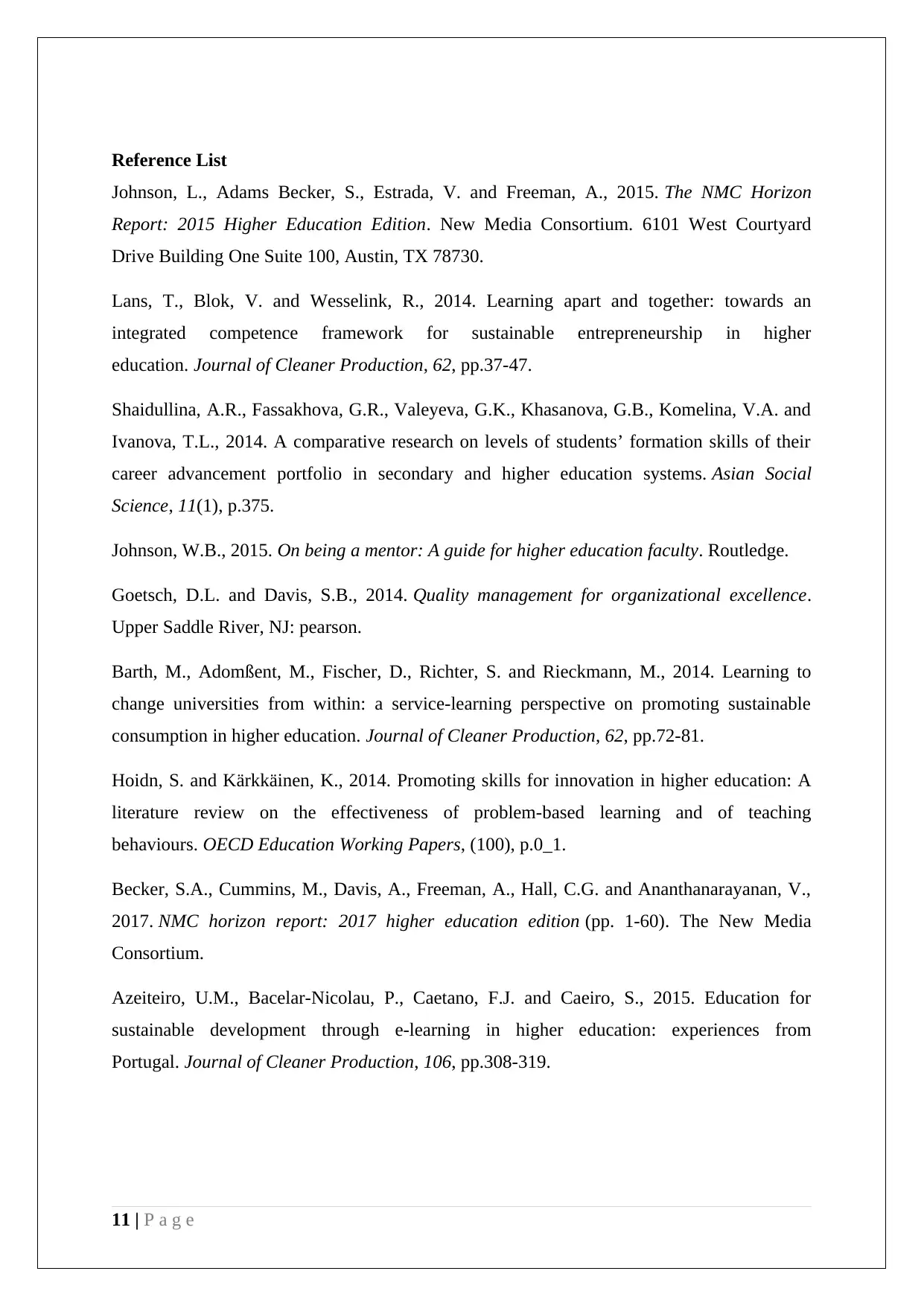
Reference List
Johnson, L., Adams Becker, S., Estrada, V. and Freeman, A., 2015. The NMC Horizon
Report: 2015 Higher Education Edition. New Media Consortium. 6101 West Courtyard
Drive Building One Suite 100, Austin, TX 78730.
Lans, T., Blok, V. and Wesselink, R., 2014. Learning apart and together: towards an
integrated competence framework for sustainable entrepreneurship in higher
education. Journal of Cleaner Production, 62, pp.37-47.
Shaidullina, A.R., Fassakhova, G.R., Valeyeva, G.K., Khasanova, G.B., Komelina, V.A. and
Ivanova, T.L., 2014. A comparative research on levels of students’ formation skills of their
career advancement portfolio in secondary and higher education systems. Asian Social
Science, 11(1), p.375.
Johnson, W.B., 2015. On being a mentor: A guide for higher education faculty. Routledge.
Goetsch, D.L. and Davis, S.B., 2014. Quality management for organizational excellence.
Upper Saddle River, NJ: pearson.
Barth, M., Adomßent, M., Fischer, D., Richter, S. and Rieckmann, M., 2014. Learning to
change universities from within: a service-learning perspective on promoting sustainable
consumption in higher education. Journal of Cleaner Production, 62, pp.72-81.
Hoidn, S. and Kärkkäinen, K., 2014. Promoting skills for innovation in higher education: A
literature review on the effectiveness of problem-based learning and of teaching
behaviours. OECD Education Working Papers, (100), p.0_1.
Becker, S.A., Cummins, M., Davis, A., Freeman, A., Hall, C.G. and Ananthanarayanan, V.,
2017. NMC horizon report: 2017 higher education edition (pp. 1-60). The New Media
Consortium.
Azeiteiro, U.M., Bacelar-Nicolau, P., Caetano, F.J. and Caeiro, S., 2015. Education for
sustainable development through e-learning in higher education: experiences from
Portugal. Journal of Cleaner Production, 106, pp.308-319.
11 | P a g e
Johnson, L., Adams Becker, S., Estrada, V. and Freeman, A., 2015. The NMC Horizon
Report: 2015 Higher Education Edition. New Media Consortium. 6101 West Courtyard
Drive Building One Suite 100, Austin, TX 78730.
Lans, T., Blok, V. and Wesselink, R., 2014. Learning apart and together: towards an
integrated competence framework for sustainable entrepreneurship in higher
education. Journal of Cleaner Production, 62, pp.37-47.
Shaidullina, A.R., Fassakhova, G.R., Valeyeva, G.K., Khasanova, G.B., Komelina, V.A. and
Ivanova, T.L., 2014. A comparative research on levels of students’ formation skills of their
career advancement portfolio in secondary and higher education systems. Asian Social
Science, 11(1), p.375.
Johnson, W.B., 2015. On being a mentor: A guide for higher education faculty. Routledge.
Goetsch, D.L. and Davis, S.B., 2014. Quality management for organizational excellence.
Upper Saddle River, NJ: pearson.
Barth, M., Adomßent, M., Fischer, D., Richter, S. and Rieckmann, M., 2014. Learning to
change universities from within: a service-learning perspective on promoting sustainable
consumption in higher education. Journal of Cleaner Production, 62, pp.72-81.
Hoidn, S. and Kärkkäinen, K., 2014. Promoting skills for innovation in higher education: A
literature review on the effectiveness of problem-based learning and of teaching
behaviours. OECD Education Working Papers, (100), p.0_1.
Becker, S.A., Cummins, M., Davis, A., Freeman, A., Hall, C.G. and Ananthanarayanan, V.,
2017. NMC horizon report: 2017 higher education edition (pp. 1-60). The New Media
Consortium.
Azeiteiro, U.M., Bacelar-Nicolau, P., Caetano, F.J. and Caeiro, S., 2015. Education for
sustainable development through e-learning in higher education: experiences from
Portugal. Journal of Cleaner Production, 106, pp.308-319.
11 | P a g e
1 out of 12
![[object Object]](/_next/static/media/star-bottom.7253800d.svg)





